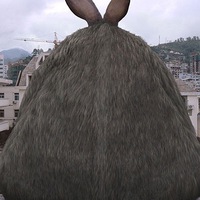(16+)
В минувшую субботу в рамках веломаршрута мы собирали по кускам Калевипоэга, эстонского мифического богатыря. Этот эпичный персонаж местных легенд, как выяснилось, имел довольно специфическую смерть. "Илья Муромец" эстонского разлива, герой-великан внушительных габаритов и несокрушимой силы, Калевипоэг, как поют нам руны, выполнял главным образом оборонительные функции, оберегая покой мирных эстов от набегов чужеземных врагов. Все стычки с Калевипоэгом кончались плохо, поэтому, чтобы раз и навсегда от него избавиться, супостатам пришлось пойти на коварство — в ночи они подкрались к нему, пока он спал, и отрезали ему обе ноги. К сожалению, мир легенд и волшебства иногда очень непоследователен и обрывается в самом неподходящем месте: ни новых ног, ни крыльев великана не появилось. Но Калевипоэг не был бы богатырем, если бы сразу сдался — нет, он бросился вслед за врагами и преследовал их столько, сколько хватало сил, пока не рухнул посреди леса и не погиб окончательно.
Покинув мир легенд, мы обнаруживаем, что у мифологического Калевипоэга тем не менее есть две вполне реальные могилы. Ноги лежат отдельно, под старинным дубом в Пюхтицком монастыре, а тело похоронено где-то неподалеку в лесу Кивинымме.
Дуб на горе мы нашли быстро — он стоит на видном месте с ограждением. Сухой и древний, от него за несколько столетий осталась только часть ствола без веток и листьев. А с телом было посложнее, так как дорожек в лесу много, а указателя нет. Что, кстати, весьма нехарактерно для местного туризма — видимо, мы выбрали действительно незаезженный маршрут. После пары попыток могила была обнаружена в глубине леса, слева от лесной дорожки. Выглядит она как совершенно обычный камень в лесу, но если присмотреться, то проявится стершаяся уже от времени гравировка — Kalevipoja kalm ("Могила Калевипоэга"). Любители загадочных историй утверждают, что в могиле был зарыт клад, многие пытались его найти, но только зря все вокруг перекопали. Более прозаичные товарищи указывают, что это просто случайно найденная в лесу могила древних эстов и бурчат на кладоискателей, разграбивших все содержимое и лишивших нас и археологов возможности узнать, что там было на самом деле.
Также нельзя не отметить, что эта древняя кровавая история увековечена ныне и в гербе Иллакуской волости. На нем ничтоже сумняшеся изображены две отрезанные ноги и меч посередине. Что сказать, нежно люблю авторов этой идеи за непосредственность.
В минувшую субботу в рамках веломаршрута мы собирали по кускам Калевипоэга, эстонского мифического богатыря. Этот эпичный персонаж местных легенд, как выяснилось, имел довольно специфическую смерть. "Илья Муромец" эстонского разлива, герой-великан внушительных габаритов и несокрушимой силы, Калевипоэг, как поют нам руны, выполнял главным образом оборонительные функции, оберегая покой мирных эстов от набегов чужеземных врагов. Все стычки с Калевипоэгом кончались плохо, поэтому, чтобы раз и навсегда от него избавиться, супостатам пришлось пойти на коварство — в ночи они подкрались к нему, пока он спал, и отрезали ему обе ноги. К сожалению, мир легенд и волшебства иногда очень непоследователен и обрывается в самом неподходящем месте: ни новых ног, ни крыльев великана не появилось. Но Калевипоэг не был бы богатырем, если бы сразу сдался — нет, он бросился вслед за врагами и преследовал их столько, сколько хватало сил, пока не рухнул посреди леса и не погиб окончательно.
Покинув мир легенд, мы обнаруживаем, что у мифологического Калевипоэга тем не менее есть две вполне реальные могилы. Ноги лежат отдельно, под старинным дубом в Пюхтицком монастыре, а тело похоронено где-то неподалеку в лесу Кивинымме.
Дуб на горе мы нашли быстро — он стоит на видном месте с ограждением. Сухой и древний, от него за несколько столетий осталась только часть ствола без веток и листьев. А с телом было посложнее, так как дорожек в лесу много, а указателя нет. Что, кстати, весьма нехарактерно для местного туризма — видимо, мы выбрали действительно незаезженный маршрут. После пары попыток могила была обнаружена в глубине леса, слева от лесной дорожки. Выглядит она как совершенно обычный камень в лесу, но если присмотреться, то проявится стершаяся уже от времени гравировка — Kalevipoja kalm ("Могила Калевипоэга"). Любители загадочных историй утверждают, что в могиле был зарыт клад, многие пытались его найти, но только зря все вокруг перекопали. Более прозаичные товарищи указывают, что это просто случайно найденная в лесу могила древних эстов и бурчат на кладоискателей, разграбивших все содержимое и лишивших нас и археологов возможности узнать, что там было на самом деле.
Также нельзя не отметить, что эта древняя кровавая история увековечена ныне и в гербе Иллакуской волости. На нем ничтоже сумняшеся изображены две отрезанные ноги и меч посередине. Что сказать, нежно люблю авторов этой идеи за непосредственность.
(16+)
Last Saturday, as part of a cycle route, we collected pieces of Kalevipoeg, an Estonian mythical hero. This epic character of local legends, as it turned out, had a rather peculiar death. "Ilya Muromets" of the Estonian spill, a giant hero of impressive size and unbreakable strength, Kalevipoeg, as the runes sing to us, served mainly defensive functions, protecting the peace of the peaceful Estonians from the attacks of foreign enemies. All the clashes with Kalevipoeg ended badly, therefore, in order to get rid of him once and for all, the adversaries had to go into deceit - in the night they crept up to him while he was sleeping and cut off both his legs. Unfortunately, the world of legends and magic is sometimes very inconsistent and breaks off in the most inappropriate place: neither the new legs, nor the wings of the giant appeared. But Kalevipoeg would not have been a warrior if he had immediately surrendered - no, he rushed after the enemies and pursued them as long as he had enough strength, until he collapsed in the middle of the forest and did not die completely.
Having left the world of legends, we discover that the mythological Kalevipoeg nevertheless has two very real graves. The legs lie separately, under an old oak tree in the Pühtitsky monastery, and the body is buried somewhere nearby in the Kivinmeme forest.
We found the oak tree on the mountain quickly - it stands in a prominent place with a fence. Dry and ancient, for several centuries only a part of the trunk remained without branches and leaves. And with the body it was more difficult, since there are many paths in the forest, but there is no pointer. Which, by the way, is very uncharacteristic of local tourism - apparently, we chose a truly unprecedented route. After a couple of attempts, the grave was discovered in the depths of the forest, to the left of the forest path. It looks like a completely ordinary stone in the forest, but if you take a closer look, engraving, already erased from time, appears - Kalevipoja kalm ("The Kalevipoega Tomb"). Fans of mysterious stories claim that a treasure was buried in the grave, many tried to find it, but only in vain dug up everything around. More prosaic comrades point out that it was just the grave of the ancient Estonians found by chance in the woods and they grumble at the treasure hunters who ransacked the entire contents and deprived us and archaeologists of the opportunity to find out what was really there.
Also, it should be noted that this ancient bloody history is immortalized now and in the arms of the Illaku parish. It shows nothing but two cut off legs and a sword in the middle. What to say, I love the authors of this idea for spontaneity.
Last Saturday, as part of a cycle route, we collected pieces of Kalevipoeg, an Estonian mythical hero. This epic character of local legends, as it turned out, had a rather peculiar death. "Ilya Muromets" of the Estonian spill, a giant hero of impressive size and unbreakable strength, Kalevipoeg, as the runes sing to us, served mainly defensive functions, protecting the peace of the peaceful Estonians from the attacks of foreign enemies. All the clashes with Kalevipoeg ended badly, therefore, in order to get rid of him once and for all, the adversaries had to go into deceit - in the night they crept up to him while he was sleeping and cut off both his legs. Unfortunately, the world of legends and magic is sometimes very inconsistent and breaks off in the most inappropriate place: neither the new legs, nor the wings of the giant appeared. But Kalevipoeg would not have been a warrior if he had immediately surrendered - no, he rushed after the enemies and pursued them as long as he had enough strength, until he collapsed in the middle of the forest and did not die completely.
Having left the world of legends, we discover that the mythological Kalevipoeg nevertheless has two very real graves. The legs lie separately, under an old oak tree in the Pühtitsky monastery, and the body is buried somewhere nearby in the Kivinmeme forest.
We found the oak tree on the mountain quickly - it stands in a prominent place with a fence. Dry and ancient, for several centuries only a part of the trunk remained without branches and leaves. And with the body it was more difficult, since there are many paths in the forest, but there is no pointer. Which, by the way, is very uncharacteristic of local tourism - apparently, we chose a truly unprecedented route. After a couple of attempts, the grave was discovered in the depths of the forest, to the left of the forest path. It looks like a completely ordinary stone in the forest, but if you take a closer look, engraving, already erased from time, appears - Kalevipoja kalm ("The Kalevipoega Tomb"). Fans of mysterious stories claim that a treasure was buried in the grave, many tried to find it, but only in vain dug up everything around. More prosaic comrades point out that it was just the grave of the ancient Estonians found by chance in the woods and they grumble at the treasure hunters who ransacked the entire contents and deprived us and archaeologists of the opportunity to find out what was really there.
Also, it should be noted that this ancient bloody history is immortalized now and in the arms of the Illaku parish. It shows nothing but two cut off legs and a sword in the middle. What to say, I love the authors of this idea for spontaneity.



У записи 27 лайков,
1 репостов,
876 просмотров.
1 репостов,
876 просмотров.
Эту запись оставил(а) на своей стене Полина Оскольская
















































